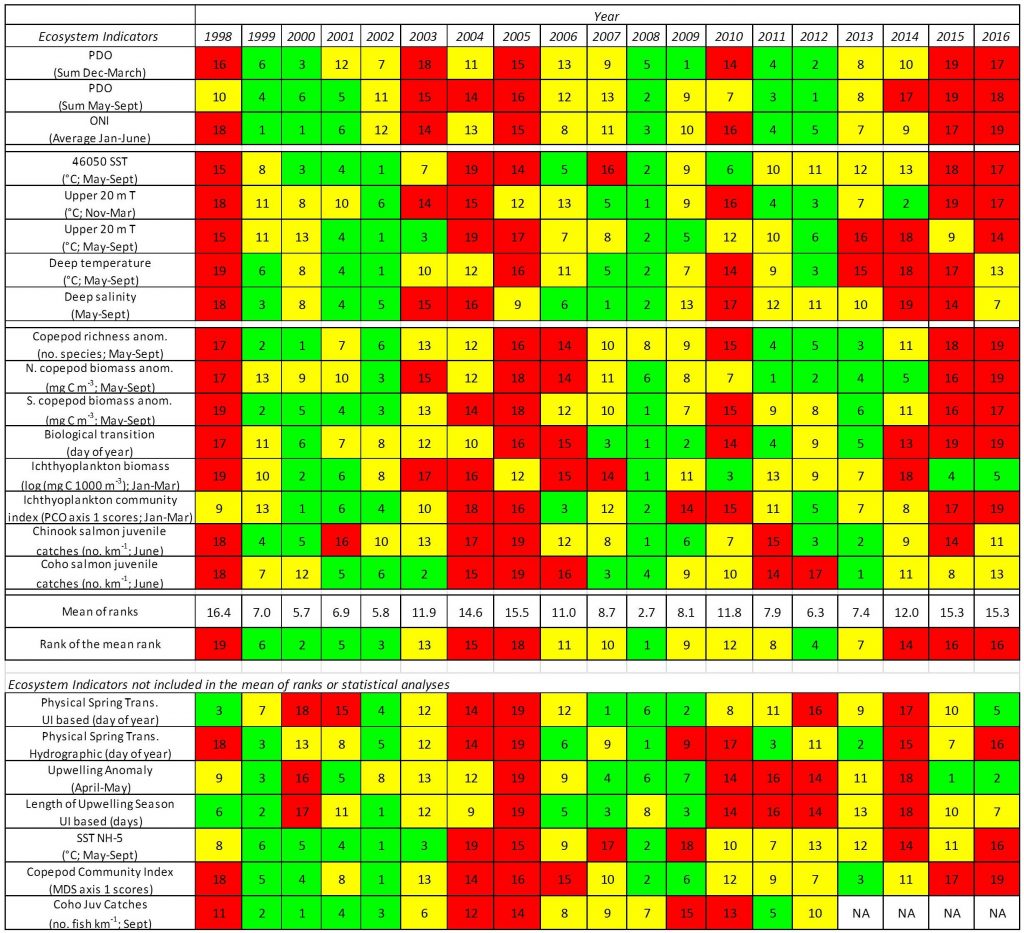NOAA Fisheries’ Northwest Fisheries Science Center states on its website1: “Similar to 2015, many of the ocean ecosystem indicators suggest 2016 to be another poor year for juvenile salmon survival, the second consecutive year of poor ocean conditions. The PDO2 was strongly positive (warm) throughout 2016, coinciding with the continuing of the anomalously warm ocean conditions in the NE Pacific initiated by the “The Blob” that began in the fall of 2013. Strong El Niño conditions at the equator also persisted throughout 2015 until May of 2016. Sea surface and upper 20 m water temperatures off Newport Oregon remained warmer than usual (+2°C) throughout most of 2016 continuing two consecutive years of anomalously warm ocean conditions.” See Figures below and at end for more details from NMFS presentation.

Mother Nature has once again dealt California salmon a deadly set of circumstances. There is not much that can be done at this point, because much of this bad hand has already been played during the 2012-2016 drought and the bad ocean conditions in 2015 and 2016. Reduction of the 2017 sport and commercial fisheries has been prescribed again to save the patient. Cutting salmon harvest is like applying a tourniquet to an amputation, yet it is necessary. Have we not learned to better prepare for such circumstances?
Once again, the blame for poor resource management is being shifted to poor ocean conditions. Evidence clearly indicates that poor inland river, Delta, and Bay conditions were also a major factor in the poor survival of salmon during the recent drought. Furthermore, evidence indicates that the fall-run hatchery salmon populations that make up most of the commercial and sport fishing catch were sustained through the drought by the transport of hatchery smolts to the Bay avoiding the poor river and Bay-Delta conditions. There was very poor survival of smolts released near upriver hatcheries during the drought compared to smolts trucked to the Delta or the Bay. This is strong evidence that the rivers and Delta are the key factors in Central Valley salmon viability.3
The same circumstances occurred in the 2004-2008 period, leading to the 2008 “salmon crash”. First came a sequence of drier years, 2001-2005; two bad ocean years, 2004 and 2005; then a flood year 2006; followed by drought years 2007 and 2008. The salmon populations did recover with better runs in 2012 and 2013 because of normal-wet river conditions in 2010-2012 and good ocean condition in 2010-2013, but the runs have since declined sharply, beginning in 2014 and culminating in the expected 2017 crash. So far, the 2017 fishery is better than expected because of the expanded hatchery transport efforts in 2014. The prognosis is not as good for the wild salmon that were not trucked to the Bay.
Declining runs in the drought years 2014 and 2015, poor young production from 2013-2015, and the poor run of two-year-old (jacks) from brood-year 2014 in 2016 are indicators of a population crash. The brood-year 2014 jacks were the consequence of cumulative bad conditions: (1) in their spawning run (summer-fall 2014), (2) during incubation and first year rearing-emigration (winter-spring 2015), (3) during their first two summers in the ocean (2015-2016), and (4) poor conditions during their run from the ocean in summer-fall 2016 from the drought hangover. Three-year-olds from the 2014 brood year are also expected to return in poor numbers in 2017, because of droughts during their parents’ spawn, poor river rearing conditions (2015), and then poor ocean conditions in 2015 and 2016.
The prognosis for brood-years 2015-2017 (2018-2020 runs) is not good for some of the same reasons, especially the expected poor numbers of spawners. These runs will carry hangovers from poor river and ocean conditions in 2015 and 2016.
One thing is lessening the overall effect on fisheries: trucking hatchery smolts to the Bay. While that is not helping the wild salmon populations in the Central Valley, or those hatchery populations not included in the trucking program, it is helping.
What can be done to improve all the salmon populations in the Central Valley?
- Reduce harvest of adults in ocean and rivers (being implemented).
- Increase hatchery production (take more eggs and rear more smolts).
- Diversify hatchery smolt production by rearing some fry in natural floodplain habitats.
- Increase hatchery smolt survival by trucking and barging to the Bay and pen acclimating in the Bay.
- Improve migration and pre-spawn holding conditions for wild and hatchery adult spawners by maintaining spring-fall migration conditions (flow and water temperatures) in lower rivers and spawning reaches.
- Maintain adequate water levels and water temperatures to sustain eggs and embryos until hatching and emergence.
- Provide optimum flows and water temperatures in rearing areas for growth and survival (minimize predation).
- Provide flow pulses to attract spawners to spawning rivers below major rim dams.
- Provide winter and spring flow pulses to stimulate juvenile emigration and to provide floodplain rearing opportunities.
- Limit South Delta exports during late fall to spring peak emigration periods.
With so many factors potentially affecting salmon survival and production, it is hard to say which of these prescriptions will be most effective. We should focus on doing them all, at least in this plentiful water year (2017).

Ocean condition indicators 1999-2016. Source: see footnote 1.
Red = poor conditions. Green = good conditions. Yellow = intermediate conditions.
